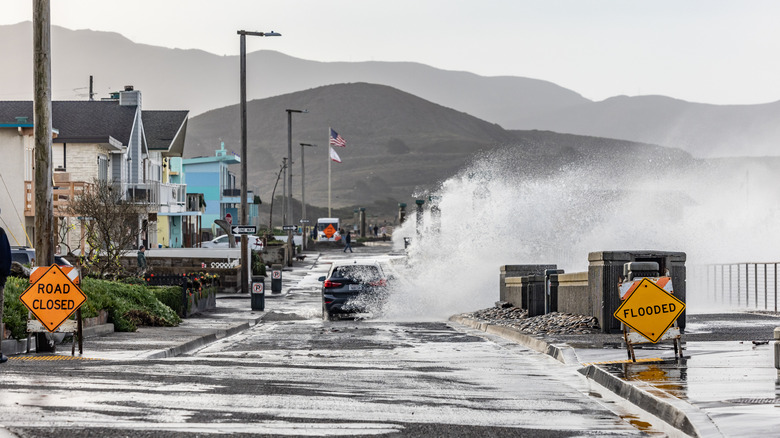The Big Change To Earth's Atmosphere That's Causing Extreme Weather
Extreme weather events are becoming more and more common as the escalating effects of climate change take their toll on our planet. The eastern seaboard of the United States has been hit with increasingly severe hurricanes and other extreme events like the East Coast Deep Freeze. On the West Coast, however, a different set of weather phenomena have been wreaking havoc, causing flash floods, knocking down trees and power lines, and triggering dangerous mudslides. They're called atmospheric rivers, and scientists have just discovered something very concerning about them.
Atmospheric rivers are currents of water vapor that form in the lower levels of the atmosphere. They form in various regions around the Earth, and the planet typically has four or five active atmospheric rivers at any given time. They play an essential role in distributing moisture through the atmosphere, but they are undergoing a dramatic shift. In October of 2024, a study published in Science Advances revealed that atmospheric rivers are moving, drifting away from the equator and concentrating towards the poles. This could radically change the weather in several regions, particularly the U.S. West Coast, parts of which will face heavier and heavier rains while other parts descend into a devastating drought.
How atmospheric rivers form
Atmospheric rivers begin in tropical regions where high temperatures cause water from the ocean to evaporate. This creates a high concentration of water vapor, which gets moved through the atmosphere by powerful winds. When the wind finally carries the atmospheric river over land, it pushes the water vapor even higher into the atmosphere, to a region so cold that the vapor condenses. At that point, the moisture carried by the atmospheric river is released as one of the kinds of precipitation.
Atmospheric rivers form all around the world, but they are most prevalent in the Pacific Ocean, where they move from the tropics northwards to the west coast of the United States and Canada. Around half of all the rain and snow that falls in California each year is carried to the state by atmospheric rivers. Probably the most famous example of such an atmospheric river is the "Pineapple Express," which originated in the Pacific Ocean near Hawaii (hence its name), and periodically belts the West Coast with torrential rains.
The consequences of atmospheric rivers moving northwards
Atmospheric rivers are an essential part of the water cycle, but recent research reveals a shift that could have disastrous implications. According to Science Advances, atmospheric river activity has shifted during the boreal winter months (December to February) as much as 10 degrees further towards the poles. This appears to have been caused by a temperature shift in the eastern Pacific Ocean, where the waters have been steadily cooling since at least 2000.
The cold region, which lies off the coast of South America, is sometimes known as the "equatorial cold tongue". It's posed a perplexing problem for scientists because it seemingly defies the rest of the world, where ocean temperatures are rising at an alarming rate. The cause isn't quite clear, but it may have to do with colder air moving in from Antarctica.
Although the exact causes aren't entirely clear, the potential consequences are. Atmospheric rivers cause 80% of floods on the West Coast of the United States, and they are responsible for around 1 billion dollars in damages annually. The shift could mean that the Pacific Northwest experiences more frequent and severe rains and flooding, while Southern California, already struggling with a drought, could become even dryer.


